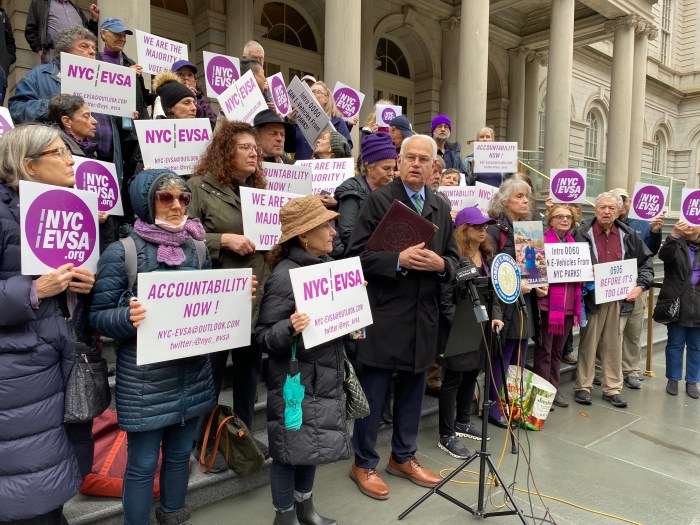Following an uptick in cycling deaths last year, the city is pursuing its first protected crosstown bike lanes in Manhattan.
The lanes — which would run between curbs and a row of parked cars — are in the early planning stages for four streets in midtown, the city’s Department of Transportation announced Wednesday. First will come two lanes on 26th and 29th streets, both stretching from the East River to the Hudson. Then will come the second pair of lanes on two, to-be-determined streets in the 50s.
“We were heartened by the progress we made with Vision Zero in New York City during 2017, the safest-ever year on our city’s streets. However, the increase in cyclist fatalities indicates just how much work we still have to do,” said DOT Commissioner Polly Trottenberg. “Too many of the cyclist tragedies happened along midtown streets without protected lanes.”
The city notched a record low 214 traffic deaths last year — the fourth straight year of declining totals under Vision Zero. But as the number of cyclists on city streets soar, biking deaths, while low, have begun trending upward. There were 23 cycling deaths last year, up from 18 in 2016 and from 14 in 2015.
Most cycling deaths occur on streets without bike lanes, according to DOT data. And several high profile fatalities last year took place on narrow crosstown streets. Dan Hanegby, 36, of Brooklyn, was struck and killed by a bus while pedaling a Citi Bike across 26th Street last June. He was the bike share service’s first death. Just a few months later, in September, another cyclist was killed not far from there on 21st Street near the intersection of Ninth Avenue.
More than 25,000 bikes cross 50th Street each day, marking a 75 percent increase from 2006, according to the DOT’s newly published study on the crosstown lanes. Citi Bike stations logged 6 million trips last year in midtown, home to the city’s busiest transit hubs, which are peppered throughout streets heavily congested with trucks making deliveries.
The city said it had selected its first two lanes primarily because the streets were wide enough to fit the protected lanes, and will provide riders a direct connection to the Hudson River Greenway. Both 26th and 29th streets are estimated to lose between two and 9 parking spaces to accommodate the lanes.
The city will seek input from midtown community boards in the coming weeks before finalizing plans. There are still questions surrounding certain aspects of the lanes, including the portion of 29th Street between Eleventh and Twelfth avenues, which is heavily used by the Sanitation Department and Con Edison.
There were 101 pedestrian deaths last year, which provides a hearty amount of data for the DOT to use to pinpoint trends and hone policies, according to Paul Steely White, the executive director of Transportation Alternatives, who lauded the city’s crosstown plans.
Cycling deaths were a bit more random, he said.
“This decision shows that city leaders have been paying attention not just to the demands of everyday cyclists, but also to the data, which show that protected bike lanes save lives,” White said in a statement. “Manhattan’s crosstown streets are like most local city streets, with parking along each curb and a wide general purpose lane which drivers use not just for travel but also for double parking.”





































